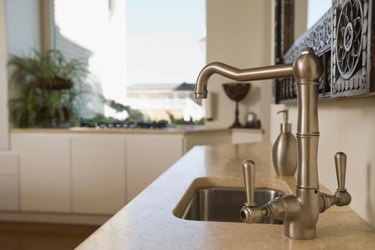Things You'll Need
Work gloves
Water pressure gauge
Flathead screwdriver
Crescent Wrench

The Watts water regulator provides homeowners with the ability to choose their preferred water pressure. The regulator controls the flow of water through your pipes to your showers and faucets. You can increase or decrease the water pressure by adjusting the regulator valve outside your home. When adjusting the regulator, you need to keep it within the normal levels. Setting the pressure outside recommended range of 40 to 60 pounds per square inch (psi) could result in broken or vibrating pipes, banging noises in your home and leaks.
Step 1
Take an initial reading of your current pressure using the water pressure gauge. Attach the gauge to a faucet and notate your current psi. If your water pressure is already at the recommended maximum or minimum, you may need to replace a faulty regulator. For example, if you want to increase your water pressure and the reading is already at 60 psi, you may need to replace a faulty regulator. Contact your water supplier before replacing since the problem may be with your water source.
Video of the Day
Step 2
Locate your regulator valve near your main waterline or meter reader. The bell-shaped valve will have a screw and a lock nut on top of it.
Step 3
Secure the screw with the screwdriver and then loosen the lock-nut with the Crescent wrench. Do not move the screw when loosening the lock nut, since it will immediately adjust your water pressure. For example, a slight random movement could decrease your water pressure, when your goal is to increase it.
Step 4
Adjust the screw slightly to the right or left. If you want lower water pressure, turn the screw to the right. Conversely, to increase water pressure, adjust the screw to the left. Turn the screw in minor increments, testing the water pressure with the gauge after each adjustment until you reach your desired setting.
Step 5
Hold the screw firmly with the screwdriver and tighten the lock nut.
Video of the Day
- "Popular Mechanics"; Homeowners Clinic; Norman Becker; November 16, 2006
- InspectAPedia: How to Adjust the Water Pressure Regulator/Pressure Reducing Valve
- "Ask the Builder"; Installing a Pressure Reducing Valve; Tim Carter; 1993-2011
- Watts: Water Safety and Flow Control
- Popular Mechanics: How to Banish Basement Pipe Problems
- ThePlumbingGuys.com: Water Pressure